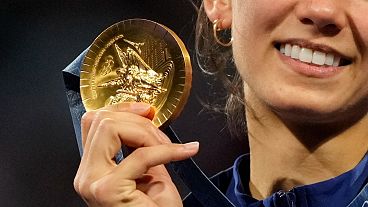The so-called “Dronegate” scandal plaguing the Canadian women’s football team is the latest use of technology being used to gain an advantage at the Olympic Games.
Before the Paris Olympic Games officially began, the Canadian women's football team were embroiled in a scandal involving a drone flown over an opponent’s practice.
New Zealand reported to French police that their practice on July 22 was disturbed by a drone, with police tracking it back to analyst Joseph Lombardi with the Canadian team.
Lombardi, head coach Bev Priestman and official Jasmine Mander were all issued one-year suspensions from any football-related activity by FIFA in response to the scandal.
Priestman also implied that drone flying is a common technique used by both men’s and women’s teams, according to the Associated Press.
Canada then failed to overturn a six-point deduction in their group and was issued a 200,000 Swiss francs (€214,845) fine.
Canada is now out of medal contention after losing 1-0 in the quarter-finals to Germany in a penalty shootout on Saturday, but the so-called “Dronegate” scandal is not the first time individual athletes or coaches have been accused of using new technology to get ahead in the Olympics.
“There has a been a history of what we could call ‘technological doping’ in sport,” according to Louis Nolte, teaching fellow in sports policy and management at the Scottish Centre for Olympic Research and Education at the University of Edinburgh.
“This situation is often complicated by the fact that different to traditional forms of doping (the use of banned substances), there is no global governing authority like the World Anti-Doping Agency (WADA), for technology”.
The circuit-breaker sword at the 1976 Olympics
Boris Onishchenko was coming off a series of disappointments at the Olympic Games: a fifth-place pentathlon finish in 1968, then an individual silver medal and team gold for the Soviet Union at the Munich Games of 1972, according to a YouTube video from the official Olympics channel.
The former three-time world individual champion was also being overshadowed on his own team, after losing his title three years in a row to Pavel Lednev. So the stage was set for the 1976 Montreal Games.
Onishchenko, now captain of Team Soviet Union, hit a couple of pentathletes in the fencing section of the competition, including the UK’s Adrian Parker, who believed he was untouchable, according to the Olympics channel.
The British thought at first that it was a malfunction of the point recording software until it happened in a second match.
So the Olympic Committee examined his épée (sword), the weapon used in fencing, and found under a layer of leather that it was wired with a circuit breaker that would register hits whenever he wanted despite not making contact with his opponents.
Onishchenko was immediately disqualified from the 1976 Games and any future Games.
The Soviet Union also withdrew their entire team from competition that year, according to ESPN.
Yet not every instance of using new technology has been for cheating. There have also been instances where sportswear or technology allowed in the games was later prohibited.
The swimsuit that set 23 Olympic records at the 2008 Games
What does an Olympic swimmer and a space shuttle have in common? They both deal with the slowing influence of drag, states a 2008 NASA press release that describes Speedo’s LZR Racer swimsuit.
Until then, NASA worked on improving the flight efficiency of its rockets against viscous drag: the force of friction that slows down a moving object through a substance, like air or water.
So when NASA was asked by SpeedoUSA to develop a swimsuit with reduced drag ahead of the 2008 Beijing Olympics, the agency dove right in.
“People would look at us and say ‘this isn’t rocket science’ and we began to think, ‘well, actually, maybe it is’,” Stuart Isaac, Speedo’s senior vice president of Team Sales and Sports Marketing, saidat the time.
The LZR Racer used hydro form compression “to grip the body like a corset,” reducing skin friction in the water by up to 24 per cent.
The space agency noted that 23 of 25 swimming world records set during the 2008 Games were by swimmers wearing the LZR Racer suit, including US’ Michael Phelps, who won a historic eight gold medals.
But by 2010, World Aquatics banned high-tech suits and now, unlike the LZR Racer, men’s suits are only allowed to extend from the waist to the knees and women’s suits are from shoulders to knees.
The Olympics notes that this is an example of when “technology went too far,” and, despite fears that the suit would lead to unbreakable world records, only six set by swimmers in the LZR Racer still stand, according to a post from June.
The double-blade runner at the 2012 Olympics
Oscar Pistorius, a South African runner and double amputee, competed in his first Paralympic Games in 2004. After winning bronze there, he was invited by World Athletics, previously the International Association of Athletics (IAAF), to compete in able-bodied races ahead of the 2008 Olympic Games.
But, by March 2007, World Athletics revised its rules and banned the use of any technical device in able-bodied running events. The belief at the time was the Cheetah Flex-Foot prosthetics used on both Pistorius’ legs gave him an advantage over able-bodied runners.
The prosthetic, invented in the 1980s, is an artificial carbon fibre leg in the shape of a J that is designed for elite Paralympic athletes, according to a 2008 New York Times profile of its founder.
“The unique shape of the Cheetah allows the prosthetic to flex and bend to impersonate foot ligaments and musculature,” a description of its patentreads. “The kinetic energy from the wearer’s steps … provides for vertical forward movements”.
The Court of Sport Arbitration decided to ban the South African athlete from running in the 2008 Olympic Games.
Pistorius later overturned that ruling and went on to compete in both the 2012 Olympics and Paralympics for South Africa. Then in 2013, he was convicted first of culpable homicide then murder in the death of his girlfriend, Reeva Steenkamp, and was released on parole in January after serving 8.5 years in prison.
Icelandic company Ossür now produces the Cheetah blades for Paralympic athletes, who won a combined total of 28 medals at the 2020 Tokyo Games.
The Vaporfly shoe controversy of 2016
Runners Eliud Kipchoge, Feyisa Lilesa and Galen Rupp wore a new pair of running shoes at the 2016 Rio Olympics: prototype Nike Vaporflys that were not yet available on the market.
All three ended up on the podium in the men’s marathon events at that Olympics.
Nike released the Zoom Vaporfly 4% shoe to the public in 2017. The Nike Vaporfly has a foam midsole that is considered lighter and less dense than other shoes on the market along with a carbon plate designed to improve a runner’s energy efficiency by at least 4 per cent.
“Form must follow function. We leveraged aerodynamic insights to deliver a radical and iconic aesthetic that screams speed," said Stefan Guest, Nike’s senior footwear design director in a 2017 press release for the new shoe.
Fast forward to 2019 and Kipchoge with his Vaporflys finished a marathon in under two hours. Another Kenyan runner, Brigid Kosgei, used the Vaporflys to smash the women’s marathon world record.
Shortly after Kipchoge’s 2019 record, World Athletics banned the use of carbon fibre plates and some track spikes from shoes used in professional events without outright banning the Vaporflys ahead of the 2020 Tokyo Games.
The ruling did say that any future shoe that uses these components would have to be on the market for at least four months before being allowed in elite competitions.
"It is not our job to regulate the entire sports shoe market but it is our duty to preserve the integrity of elite competition by ensuring that the shoes worn by elite athletes in competition do not offer any unfair assistance or advantage," Sebastian Coe, president of World Athletics, said in a statement at the time.















